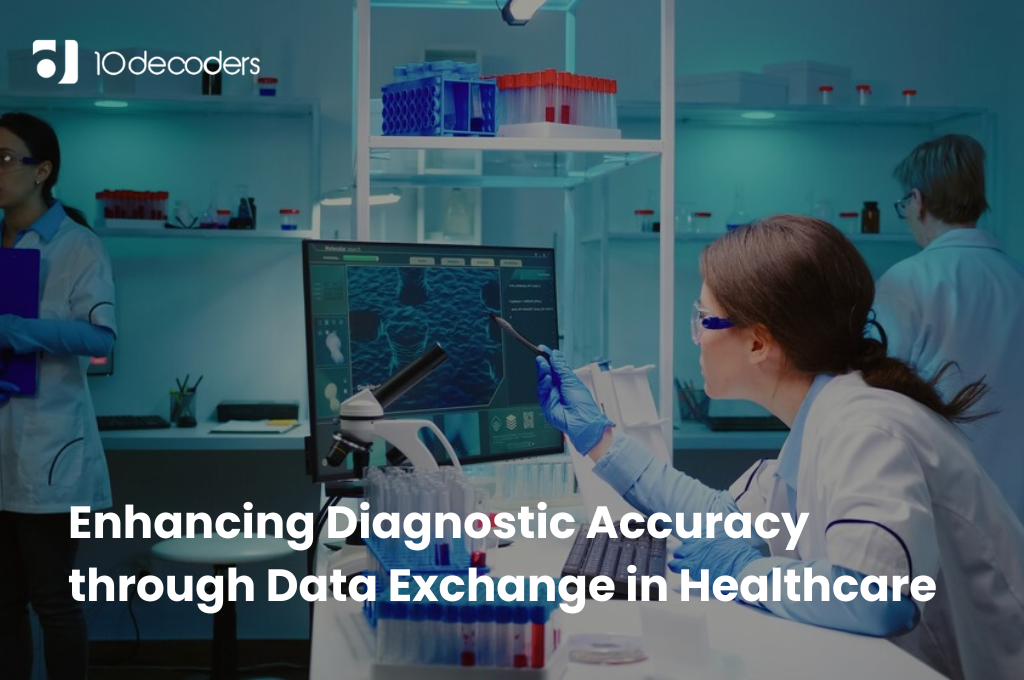Enhancing Diagnostic Accuracy through Data Exchange in Healthcare
In today’s data-driven healthcare landscape, accurate diagnosis plays a pivotal role in ensuring optimal patient outcomes. Early detection and precise identification of diseases empower clinicians to initiate timely interventions, improving treatment efficacy and minimising complications. However, diagnostic accuracy can be hampered by fragmented data siloed across various healthcare institutions and modalities. This is where seamless data exchange emerges as a transformative force, paving the way for a paradigm shift in diagnostic precision.
The Fragmented Landscape: A Barrier to Accuracy
Traditionally, medical records have been confined to individual healthcare providers, often stored in disparate electronic health records (EHRs) or paper charts. This fragmentation creates significant challenges for accurate diagnosis
- Limited visibility: Clinicians often lack access to a patient’s complete medical history, including past diagnoses, treatments, and medications prescribed by other providers. This blind spot can lead to missed connections and misinterpretations, potentially delaying or hindering proper diagnosis.
- Redundant testing: Duplicate laboratory tests or imaging studies are frequently ordered due to the unavailability of previous results. This not only exposes patients to unnecessary risks and costs but also delays diagnosis and treatment initiation.
- Inconsistent data: Variations in data formats and coding practices across different institutions can lead to misinterpretations and errors, further compromising diagnostic accuracy.
Data Exchange: Bridging the Gaps
The seamless exchange of healthcare data holds immense potential to overcome these challenges and revolutionise diagnostic accuracy. By enabling secure and efficient flow of medical information across various stakeholders, data exchange empowers clinicians with a holistic view of a patient’s health journey
- Comprehensive patient profiles: Access to a patient’s complete medical history, including diagnoses, medications, allergies, and family history, allows for a more comprehensive understanding of their health status and potential disease risks. This facilitates informed clinical decision-making and reduces the likelihood of misdiagnosis.
- Reduced redundancy: Sharing diagnostic test results across institutions eliminates the need for repetitive testing, minimising patient exposure to unnecessary procedures and associated costs. Additionally, it provides valuable insights from previous examinations, aiding in accurate diagnosis and treatment planning.
- Standardised data: Implementing interoperable data standards and formats ensures clear and consistent communication of medical information, minimising errors and misinterpretations that can hinder diagnostic accuracy.
Beyond Diagnosis: Empowering Personalized Care
The benefits of data exchange extend beyond improving diagnostic accuracy. It fosters a collaborative healthcare environment where
- Clinical research: Aggregated and anonymized patient data can be utilised for research purposes, accelerating the development of new diagnostic tools and personalised treatment strategies.
- Public health initiatives: Real-time data sharing can facilitate outbreak monitoring and surveillance, enabling rapid response to public health threats and improving preventative measures.
- Patient engagement: Patients can be empowered to access their own medical records and participate actively in their healthcare decisions, fostering informed collaboration with their clinicians.
The Impact on Diagnostic Accuracy
By enabling access to a richer and more comprehensive dataset, seamless data exchange empowers healthcare professionals in several ways, ultimately leading to improved diagnostic accuracy
- Enhanced Pattern Recognition: Machine learning algorithms trained on vast amounts of de-identified patient data can identify subtle patterns and correlations between symptoms, diagnoses, and treatments that might be missed by human eyes. This can lead to earlier detection of diseases and more accurate diagnoses, especially for complex or rare conditions.
- Reduced Diagnostic Bias: Siloed data can lead to confirmation bias, where healthcare professionals focus on information that confirms their initial diagnosis and overlook alternative possibilities. Access to a wider range of data reduces this bias, promoting a more objective and evidence-based approach to diagnosis.
- Improved Treatment Planning: Knowing a patient’s complete medical history and genetic makeup allows for the development of personalised treatment plans that are tailored to their individual needs and response probabilities. This can lead to more effective therapies and improved outcomes.
Challenges and Considerations
While the potential of data exchange is undeniable, its successful implementation requires addressing certain challenges
- Data privacy and security: Robust data governance frameworks and cybersecurity measures are crucial to ensure patient privacy and prevent unauthorised access to sensitive medical information.
- Technological infrastructure: Interoperability between different EHR systems and healthcare platforms is essential for seamless data exchange.
- Standardisation: Establishing standardised data formats and coding practices across healthcare institutions is vital for accurate interpretation and communication of medical information.
- Ethical considerations: Concerns regarding data ownership, secondary use of patient data, and potential biases in algorithms need to be carefully addressed to ensure ethical and responsible data exchange practices.
Conclusion: A Collaborative Future for Accurate Diagnosis
Seamless data exchange has the potential to revolutionise healthcare by enhancing diagnostic accuracy, streamlining clinical workflows, and fostering personalised care. By overcoming the challenges and implementing robust data governance frameworks, healthcare institutions can leverage the power of data to paint a comprehensive picture of each patient’s health, enabling clinicians to make informed decisions and ultimately improve patient outcomes. As we move towards a more collaborative and data-driven healthcare ecosystem, the accurate diagnosis fueled by seamless data exchange will undoubtedly pave the way for a healthier future.



